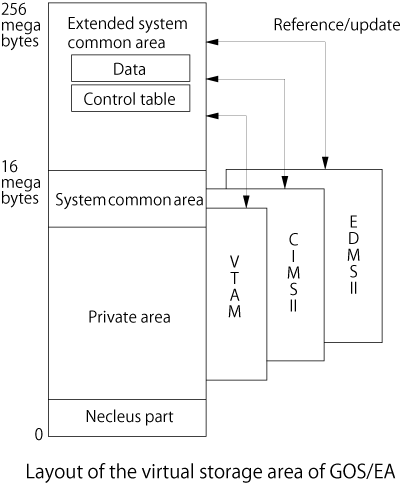GOS/EA was the operating system for EX860II, EX870II and EX880II general-purpose computers announced by Mitsubishi Electric in 1990, which were the highest-level models of the MELCOM EX series. Extending the size of virtual storage of GOS/VS enabled the new operating system to support an increased number of terminals and improved system performance in an online system.
GOS/EA adopted the multiple virtual storage method used in GOS/VS, but the virtual storage area was extended from 16 MB to 256 MB. Of the total virtual storage area, the portion up to 16 MB was compatible with that of GOS/VS and consisted of a system common area and private areas, allowing the existing program to operate as-is. The remaining portion above 16 MB was called extended system common area and served as a data area, and virtual storage access method (VSAM), virtual telecommunication access method (VTAM) and online database management systems (CIMS II and EDMS II) was able to acquire and release them dynamically. Tables for the control program that managed the extended system common area were also placed in the extended system common area.
For VSAM, resources shared by global resource-sharing (GSR) functions, such as buffers and control blocks, were placed in the extended system area to relax the scale limit. In addition, it was possible to divide buffers into up to 16 pools to minimize the overhead of buffer search in order to respond to the increase of the number of buffers.
For VTAM, the number of supportable logical terminals was increased by transferring part of the control tables to the extended system common area.
For CIMS II, the number of terminals and the processing capability with a simplified query model were more than doubled as a result of utilizing the above enhanced functions, having the business program logic part shared among programs by placing the part in the extended system common area, and placing the files used exclusively for search in the extended system common area as memory files.
For EDMS II, scale was increased and the database processing performance was improved by placing information on processing management and the I/O buffer for databases in the extended system common area, and by allowing business programs to be distributed to multiple spaces.

- Home >
- Historical Computers in Japan >
- Mainframe OS >
- GOS/EA
【Mitsubishi Electric】 GOS/EA

All Rights Reserved, Copyright (C) Information Processing Society of Japan
